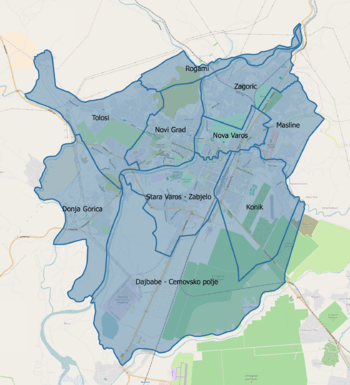Podgorica
Podgorica (Cyrillic: Подгорица, [pǒdɡoritsa]; lit. '"[area] below Gorica"') is the capital and largest city of Montenegro.
Podgorica Подгорица | |
|---|---|
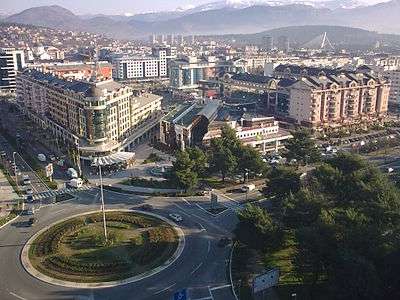   Podgorica panoramic view, Republic Square, Dajbabska Gora Tower, Montenegrin National Theatre building, Telenor Centre, Moscow and Millennium bridges | |
 Podgorica Location of Podgorica in Montenegro 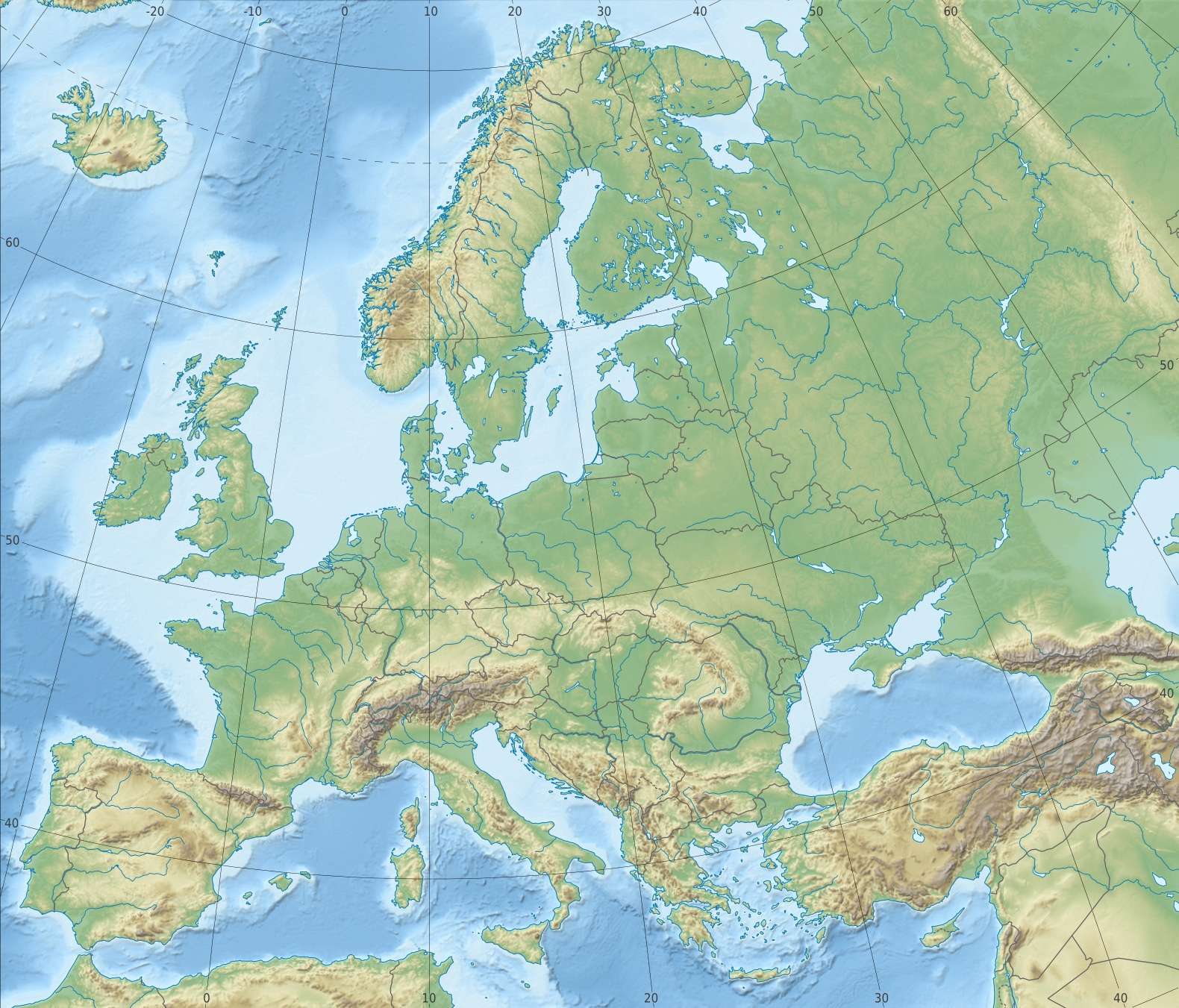 Podgorica Podgorica (Europe) | |
| Coordinates: 42°26′28.63″N 19°15′46.41″E | |
| Country | |
| Municipality | Podgorica Capital City |
| Founded | Before 11th century |
| Government | |
| • Mayor | Ivan Vuković (DPS) |
| • Ruling coalition | DPS-SD |
| Area | |
| • City | 108 km2 (42 sq mi) |
| • Metro | 1,441 km2 (556 sq mi) |
| Elevation | 40 m (130 ft) |
| Population | |
| • Urban | |
| • Rural | |
| • Metro | |
| Demonym(s) | Podgoričanin (male)Podgoričanka (female) |
| Time zone | UTC+01:00 (CET) |
| Postal code | 81 000 – 81 124 |
| Area code(s) | +382 20 |
| License plate | PG |
| Website | Podgorica Capital City |
The city was known as Titograd (Cyrillic: Титоград [tîtoɡraːd]) between 1946 and 1992—in the period that Montenegro formed, as the Socialist Republic of Montenegro, part of the Socialist Federal Republic of Yugoslavia (SFRY)—in honour of Josip Broz Tito.
Podgorica's favorable position at the confluence of the Ribnica and Morača rivers and at the meeting-point of the fertile Zeta Plain and Bjelopavlići Valley has encouraged settlement. The city is close to winter skiing centers in the north and to seaside resorts on the Adriatic Sea.
Podgorica Municipality covers 10.4% of Montenegro's territory and is home to 29.9% of the country's population. It is the nation's administrative center and its economic, cultural, and educational focus.
Name and etymology
Podgorica is written in Cyrillic as Подгорица, pronounced [pǒdɡoritsa]; UK: /ˈpɒdɡɒrɪtsə, pɒdˈɡɔːr-/,[3] US: /ˈpɒdɡəriːtsə, ˈpɔːdɡɒr-/;[4][5][6]
Podgorica (Подгорица) literally means "[area] below Gorica". Gorica, meaning "little hill", is the name of one of the cypress-covered hillocks that overlooks the city center.
Some three kilometres (1.9 miles) north-west of Podgorica lie the ruins of the Roman-era town of Doclea, from which the Roman Emperor Diocletian hailed. In later centuries, Romans "corrected" the name to Dioclea, guessing wrongly that an i had been lost in vulgar speech. Duklja is the later South Slavic version of that word.
At its foundation (some time before the 11th century), the town was called Birziminium. In the Middle Ages, it was known as Ribnica (Cyrillic: Рибница [rîbnitsa]). The name Podgorica was used from 1326. From 1946 to 1992, the city was named Titograd in honour of Josip Broz Tito, the President of Yugoslavia from 1953 to 1980.
History
Early history
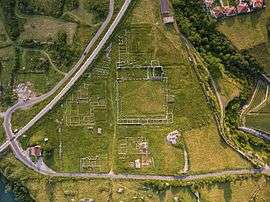
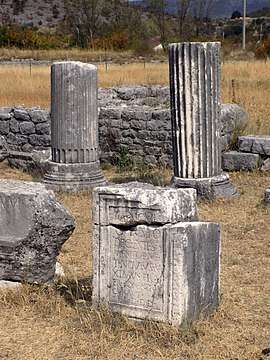
Podgorica is at the crossroads of several historically important routes, near the rivers Zeta, Morača, Cijevna, Ribnica, Sitnica and Mareza in the valley of Lake Skadar and near the Adriatic Sea, in fertile lowlands with favourable climate. The earliest human settlements were in prehistory: the oldest physical remains are from the late Stone Age.
In the Iron Age, the area between the Zeta and Bjelopavlići valleys was occupied by two Illyrian tribes, the Labeates and the Docleatae. The population of the town of Doclea was 8,000–10,000, in which all core urban issues were resolved. The high population density (in an area of about 10 km (6 mi) radius) was made possible by the geographical position, favorable climate, and economic conditions and by the defensive positions that were of great importance at that time.
Middle Ages
From the 5th century AD, with the arrival of the first Slavic and Avar tribes and the beginning of the break-up of the Roman Empire, the area bore witness to many noteworthy events. With time, the fortifications ceased their function, and new towns were built; a new settlement probably named after the Ribnica river, on whose banks it was built, Ribnica, was established. It was first mentioned during the reign of the Nemanjić dynasty, as part of the Serbian kingdom. The importance of Ribnica was its position as crossroads in communications with the west.
The name Podgorica was first mentioned in 1326 in a court document of the Kotor archives. The city was economically strong: trade routes between the Republic of Ragusa and Serbia, well developed at that time, were maintained via the road that led to Podgorica through Trebinje and Nikšić. As a busy crossroads, Podgorica was a vibrant regional center of trade and communication. This boosted its development, economic power, military strength, and strategic importance.
Ottoman Empire
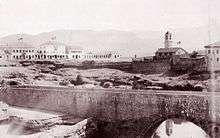
The Ottoman Empire captured Podgorica in 1474. Podgorica became a kaza of the Sanjak of Scutari (which was historically led by Albanian Pashas) in 1479 The Ottomans built a large fortress in Podgorica, and the existing settlement, with its highly developed merchant connections, became the main Ottoman defensive and attacking bastion in the region. At the beginning of 1474 the Ottoman sultan intended to rebuild Podgorica and Baleč and settle them with 5,000 Muslim families (most of then Albanian or Slavic origin),[7] in order to stop cooperation between the Principality of Zeta and Albania Veneta.[8]
Podgorica fell again, but this time to the Ottomans in 1484, and the character of the town changed extensively. The Ottomans fortified the city, building towers, gates, and defensive ramparts that give Podgorica the appearance of an Ottoman military city.
Most of today's Montenegro and Podgorica fell under the rule of the Albanian Bushati Family of Shkodra between 1760 and 1831, which ruled independently from the Imperial authority of the Ottoman Sultan.
In 1864, Podgorica became a kaze of the Scutari Vilayet called Böğürtlen ("blackberry", also known as Burguriçe).
On October 7, 1874, in a violent reaction over the murder of a local named Juso Mučin Krnić,[9] Ottoman forces killed at least 15 people in Podgorica.[10] The massacre was widely reported outside of Montenegro and ultimately contributed to the buildup to the Montenegrin-Ottoman War.
The end of the Montenegrin-Ottoman War in 1878 resulted in the Congress of Berlin recognizing vast territories, including that of Podgorica, as part of the newly recognized Kingdom of Montenegro. At that time there were about 1,500 houses in Podgorica, with more than 8,000 people living there - of Orthodox, Roman Catholic, and Muslim faiths flourishing together.
The Petrović and Karađorđević monarchies
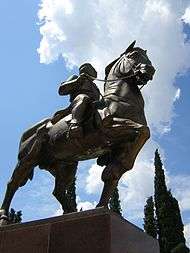
After the Berlin Congress in 1878, when Podgorica was annexed to the Principality of Montenegro, marking the end of four centuries of Ottoman rule, and the beginning of a new era for Podgorica and Montenegro. The first forms of capital concentration were seen in 1902 when roads were built to all neighboring towns, and tobacco became Podgorica's first significant commercial product. Then in 1904, a savings bank named Zetska formed the first significant financial institution, and it would soon grow into Podgorička Bank.
World War I marked the end of dynamic development for Podgorica, which by then was the largest city in the newly proclaimed Kingdom of Montenegro. On August 10, 1914, nine military personnel and 13 civilians were killed in Podgorica from an aerial bombardment by Austro-Hungarian Aviation Troops.[11] The city was bombed three more times in 1915.[11] Podgorica was occupied, as was the rest of the country, by Austria-Hungary from 1916 to 1918.
After the liberation by the Allies in 1918, the controversial Podgorica Assembly marked the end of Montenegrin statehood, as Montenegro was merged with the Kingdom of Serbia and incorporated into the Kingdom of Serbs, Croats, and Slovenes. The population of urban Podgorica during this interwar period was approximately 14,000.[12]
During the interwar period (1918–1941), Podgorica had public bathrooms as most residents did not have their own.[12] However, the Imperial hotel built-in 1925 had two bathrooms, which was unprecedented at the time.[12] It was one of at least six hotels built in the city during the interwar period.[12]
World War II
After the Yugoslav coup d'état on March 27, 1941, demonstrations supporting the coup took place in Podgorica.[13] As a result of the coup, Yugoslavia turned against its previous alliance with the Axis powers and was subsequently invaded. Podgorica was bombed over 80 times throughout the course of the war.[14] The city was first bombed by the Luftwaffe on April 6, 1941. On May 5, 1944, Podgorica was bombed by the USAAF in an attack against Axis forces, although the bombardment that day killed approximately 400 civilians.[15] The city was liberated on December 19, 1944. According to the Belgrade Museum of Genocide Victims, a total of 1,691 people were killed in Podgorica over the course of the war.[16]

Socialist Yugoslavia
On July 12, 1946, Josip Broz Tito made one of his early visits to Podgorica from the Radovče hotel, where he spoke to a crowd.[17] It was the first of fifteen total visits made by Tito to the city after World War II.[17]
"Podgorica is destroyed. We will build her altogether because it's our responsibility because that's what's required of us by the sacrifices which Podgorica gave! We will do it, that's what I promise you in the name of the Federal government." -Josip Broz Tito from the Radovče hotel on July 12, 1946.[17]
On July 25, 1948, the vice president of the People's Parliament of Montenegro, Andrija Mugoša, along with secretary Gavron Cemović, signed a law changing the name of Podgorica into "Titovgrad".[14] The law was "retroactively" activated such that the name change applied to any records starting from July 13, 1946, when it became the capital of Montenegro within the newly formed Socialist Federal Republic of Yugoslavia.[14] However, in a glaring contradiction, the "Službeni list" or legal code of Yugoslavia recorded the name "Titograd" without the letter "v".[14] Ultimately, "Titograd" was used over "Titovgrad".[14]
In addition to the new name, Titograd saw the establishment of new factories. The Radoje Dakić factory, built-in 1946 for the production of heavy machinery, became one of the largest employers in Titograd. In 1964, Radoje Dakić guaranteed hired workers an apartment in the city.[18] In the late 1960s, the cities of Titograd, Zadar, and Mostar competed to be selected as the location of Yugoslavia's expanding aluminum industry.[19] In a highly politicized selection process, Titograd was ultimately chosen and the Kombinat was constructed in 1969.[19] In 1974, the public Veljko Vlahović University was founded in Titograd. On April 15, 1979, the city suffered damage by a 6.9 magnitude earthquake.
Titograd was the site of massive protests during Yugoslavia's anti-bureaucratic revolution. On January 10, 1989, over 10,000 people protested in the city.[20][21] By the turn of the decade, Titograd was recognized as the city with the most greenery in Yugoslavia, along with Banja Luka.[22]
Contemporary history
As Yugoslavia began to break up, Titograd was renamed to Podgorica after a referendum on April 2, 1992.[23] The Yugoslav wars largely bypassed Montenegro, but the entire country was greatly affected with severe economic stagnation and hyperinflation lasting throughout the 1990s due to international sanctions. In 1999, Podgorica was subject to airstrikes during the NATO bombing of Yugoslavia.[24][25]
Following the results of the independence referendum in May 2006, Podgorica became the official capital of an independent state.
On October 13, 2008, at least 10,000 people protested Kosovo's declaration of independence.[26] In October 2015, protests took place in Podgorica ahead of Montenegro's accession into NATO. After a demonstration of at least 5,000 to 8,000 people,[27] the police used tear gas to disperse demonstrators from the parliament.[28] Protests in the city continued through the 2016 Montenegrin parliamentary election. On February 22, 2018, a Yugoslav Army veteran killed himself at the US embassy in Podgorica.
Geography
Podgorica is located in central Montenegro. The area is crossed with rivers and the city itself is only 15 kilometres (9.3 mi) north of Lake Skadar. The Morača and Ribnica rivers flow through the city, while the Zeta, Cijevna, Sitnica and Mareza flow nearby. Morača is the largest river in the city, being 70 m or 230 ft wide near downtown, and having carved a 20 m or 66 ft deep canyon for the length of its course through the city. Except for the Morača and Zeta, other rivers have an appearance of small creeks. The richness in bodies of water is a major feature of the city.
In contrast to most of Montenegro, Podgorica lies in a mainly flat area at the northern end of the Zeta plain, at an elevation of 40 m (130 ft). The only exceptions are hills which overlook the city. The most significant is 130.3 m (427 ft) high Gorica Hill (pronounced [ˈɡǒrit͜sa]), city's namesake, which rises above the city centre. The other hills include Malo brdo ("little hill", 205.4 m or 674 ft), Velje brdo ("big hill", 283 m or 928 ft), Ljubović (101 m or 331 ft) and Dajbapska gora (172 m or 564 ft). For the most part, these are too steep for development and thus limit the city's expansion, especially to the north. However, urbanization has been encroaching on the lower slopes of the hills since the 1990s. Podgorica city proper has an area of 108 square kilometres (42 sq mi), while actual urbanized area is much smaller.
.jpg) Morača river canyon.
Morača river canyon. River Cijevna waterfalls near Podgorica
River Cijevna waterfalls near Podgorica- Podgorica panoramic view.
Climate
Under the Köppen climate classification, Podgorica has a humid subtropical climate (Cfa instead of Csa), since there is only one summer month with less than 40 millimeters (1.6 in) of precipitation,[29] with summer highs around 30 °C (86 °F) and winter highs around 10 °C (50 °F). Although the city is only some 35 km (22 mi) north of the Adriatic Sea, an arm of the Mediterranean, Rumija mountain acts as a natural Dinaric Alps barrier, separating Skadar Lake basin and Podgorica area from the sea, thus limiting temperate maritime influence on the local climate.
The mean annual rainfall is 1,659 mm (65.3 in), making Podgorica by far wettest capital in Europe, Ljubljana being second with 1,362 mm (53.6 in). The temperature exceeds 25 °C (77 °F) on about 135 days each year and the median daily temperature is 15.6 °C (60.1 °F). The number of rainy days is about 120, and those with a strong wind around 60. An occasional strong northerly wind influences the climate in the winter, with a wind chill effect lowering the perceived temperature by a few degrees.
The all-time maximum snowfall record was beaten on 11 February 2012, when 58 cm (23 in) of snowfall were measured. Before that, the biggest snowfall in Podgorica was in 1954, when 52 cm (20 in) of snowfall was recorded. Maximum temperature was recorded on 24 August 2007, at 44.8 °C (112.6 °F), while all time minimum was −9.7 °C (14.5 °F), on 4 February 1956.
| Climate data for Podgorica (1961–1990, extremes 1951–2018) | |||||||||||||
|---|---|---|---|---|---|---|---|---|---|---|---|---|---|
| Month | Jan | Feb | Mar | Apr | May | Jun | Jul | Aug | Sep | Oct | Nov | Dec | Year |
| Record high °C (°F) | 18.8 (65.8) |
23.0 (73.4) |
27.0 (80.6) |
31.0 (87.8) |
33.8 (92.8) |
38.5 (101.3) |
41.8 (107.2) |
42.5 (108.5) |
38.9 (102.0) |
32.2 (90.0) |
27.4 (81.3) |
20.0 (68.0) |
42.5 (108.5) |
| Average high °C (°F) | 9.5 (49.1) |
11.3 (52.3) |
15.0 (59.0) |
19.1 (66.4) |
24.3 (75.7) |
28.3 (82.9) |
31.8 (89.2) |
31.6 (88.9) |
27.4 (81.3) |
21.7 (71.1) |
15.5 (59.9) |
11.1 (52.0) |
20.6 (69.0) |
| Daily mean °C (°F) | 5.0 (41.0) |
6.8 (44.2) |
10.0 (50.0) |
13.9 (57.0) |
19.0 (66.2) |
22.8 (73.0) |
26.0 (78.8) |
25.6 (78.1) |
21.4 (70.5) |
15.9 (60.6) |
10.5 (50.9) |
6.5 (43.7) |
15.3 (59.5) |
| Average low °C (°F) | 1.4 (34.5) |
3.2 (37.8) |
5.8 (42.4) |
9.2 (48.6) |
13.6 (56.5) |
17.3 (63.1) |
20.3 (68.5) |
20.2 (68.4) |
16.5 (61.7) |
11.6 (52.9) |
6.8 (44.2) |
2.9 (37.2) |
10.7 (51.3) |
| Record low °C (°F) | −17.0 (1.4) |
−10.9 (12.4) |
−8.4 (16.9) |
−0.5 (31.1) |
2.5 (36.5) |
8.2 (46.8) |
11.0 (51.8) |
9.0 (48.2) |
4.0 (39.2) |
−1.5 (29.3) |
−7.4 (18.7) |
−10.0 (14.0) |
−17.0 (1.4) |
| Average precipitation mm (inches) | 191.6 (7.54) |
166.5 (6.56) |
159.0 (6.26) |
145.2 (5.72) |
89.8 (3.54) |
63.3 (2.49) |
38.5 (1.52) |
65.9 (2.59) |
119.6 (4.71) |
164.2 (6.46) |
238.5 (9.39) |
217.2 (8.55) |
1,659.3 (65.33) |
| Average precipitation days (≥ 0.1 mm) | 12 | 12 | 12 | 13 | 10 | 9 | 5 | 6 | 7 | 9 | 14 | 13 | 122 |
| Average relative humidity (%) | 72 | 68 | 65 | 65 | 63 | 60 | 52 | 52 | 62 | 68 | 75 | 74 | 65 |
| Mean monthly sunshine hours | 122.7 | 126.0 | 170.0 | 193.5 | 250.8 | 276.3 | 339.7 | 314.1 | 251.5 | 201.4 | 126.4 | 108.8 | 2,481.2 |
| Source 1: Hydrological and Meteorological Service of Montenegro[30] | |||||||||||||
| Source 2: Pogodaiklimat.ru (record high and low)[31] | |||||||||||||
Cityscape
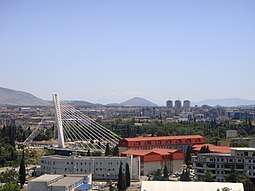
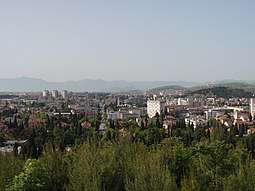
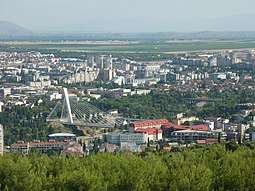
Podgorica's mixture of architectural styles reflects the turbulent history of the city and country: as one régime replaced another, the corresponding style was introduced.
As part of the Ottoman Empire until 1878, Podgorica has some examples of Ottoman architecture. The oldest parts of the city, Stara Varoš (Old town) and Drač is typical of this, with two mosques, a Turkish clock tower and narrow, winding streets.
_(9185505567).jpg)
When the city was incorporated to Montenegro, the urban core shifted to the other bank of the Ribnica River, where the town developed in a more European style: wider streets with an orthogonal layout. This part of the city is today traditionally regarded as the city center and is called Nova Varoš (New town)
During World War II, Podgorica was almost razed to the ground, being bombed over 70 times. After liberation, rebuilding began as in other cities of the communist-ruled SFRY. Mass residential blocks were erected, with basic design typical of Eastern bloc countries. All that part of the city on the right bank of the Morača River was built this way.
The main contemporary traffic arteries were laid out during this period, which extended the orthogonal street layout of the city center, to the south and west. Residential and infrastructural developments in the SFRY era have mostly shaped the layout of today's Podgorica and accommodated the unprecedented population growth that followed World War II.
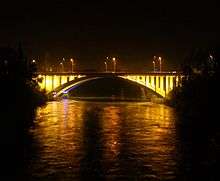 Blažo Jovanović Bridge over the Morača.
Blažo Jovanović Bridge over the Morača.- Office building at George Washington Street
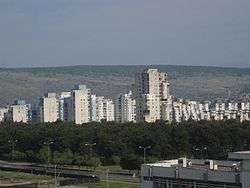 Highrise housing in Podgorica.
Highrise housing in Podgorica.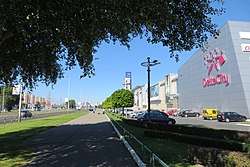
 St Peter of Cetinje Boulevard
St Peter of Cetinje Boulevard
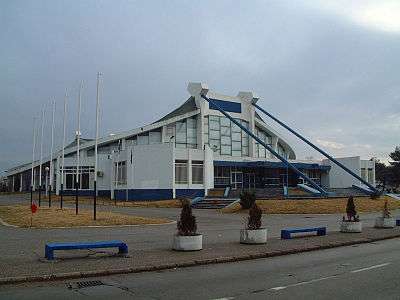
A major advance in Podgorica architecture began in the late 1990s and, since then, the face of the city has changed rapidly. Residential and business construction are proceeding rapidly, incorporating contemporary glass-and-steel architectural trends. In an effort to create a recognizable and modern state capital, city officials are routing significant investments in the city's public spaces. Thus, the city has gained entirely new squares and some monuments. New landmarks include the Hristovog Vaskrsenja orthodox temple and the Millennium Bridge, the main feature of the Podgorica skyline.
Culture
Podgorica is home to many Montenegrin cultural institutions and events. It hosts the Montenegrin National Theatre and a number of museums and galleries. The Montenegrin National Theatre is the most significant theatre not only in Podgorica but in all of Montenegro. Podgorica is also host to the City Theatre (Gradsko pozorište), which includes the Children's Theatre and the Puppet Theatre. Although not as rich in museums and galleries as the historic royal capital Cetinje, there are several noteworthy museums:
.jpg)
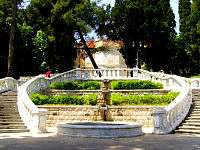
- The Podgorica City Museum (Muzej grada Podgorice) preserves Podgorica's rich heritage. Founded in 1950, it has four categories: archaeological, ethnographic, historical, and cultural-historical. It houses artifacts that date back to the Roman and Illyrian eras.
- The Archaeological Research Centre (Centar za arheološka istraživanja) was founded in 1961. Its mission is to gather, classify, restore and display archaeological sites.
- The Marko Miljanov Museum (Muzej Marka Miljanova) in Medun shows life in 19th century Montenegro.
- The Natural History Museum (Prirodnjački muzej) displays specimens of Montenegrin flora and fauna. This museum has no exhibition space of its own, despite many proposals and initiatives to build one.
There is a notable art gallery in the Dvorak Petrovića (Petrović Castle) complex in Podgorica's largest public park. King Nicholas's castle, Perjanički Dom (House of the Honour Guard), castle chapel and surrounding buildings were converted to an art gallery in 1984. Since 1995, it has been part of the Modern Arts Centre (Centar savremenih umjetnosti) and houses approximately 1,500 works of art. The historic Cinema of Culture (Kino Kultura), which was founded in 1949, was closed in November 2008 due to continuous financial losses it generated. It was the only cinema in the city for 6 decades. The building of the former cinema will be converted to host the Podgorica City Theatre. Shortly after its closure, a Ster-Kinekor (later acquired by Cineplexx) 6-screen multiplex cinema opened at Delta City shopping mall.
A significant cultural institution of over fifty years' standing is the Budo Tomović Cultural-Informational Centre (KIC Budo Tomović). It is a public institution that organizes various artistic events, including Podgorica Cultural Summer (Podgoričko Kulturno Ljeto), FIAT – International Alternative Theatre Festival (Festival Internacionalnog Alternativnog Teatra), DEUS – December Arts Scene (Decembarska Umjetnička Scena).
Media
Podgorica is the media hub of Montenegro. It is home to the headquarters of the state-owned public television broadcaster RTCG. Commercial broadcasters in Podgorica include RTV A1, TV Vijesti, Nova M and Prva TV. It was announced that the city's local television will be launched soon.[32] Their programmes can be received in much of Montenegro.
All Montenegro's daily newspapers (oldest Montenegrin daily newspaper Pobjeda, Vijesti, Dnevne Novine and Dan) are published in Podgorica, as the weekly magazines Monitor and Magazin BIT.
Sports
The most popular sports by far are football and basketball. Basketball became especially popular with the success in the late 20th and early 21st centuries of KK Budućnost, both in Regional and European competitions.
Football in Podgorica has a long tradition associated with Budućnost. World-famous players Predrag Mijatović and Dejan Savićević were born in Podgorica and made their debut in that team. The club FK Zeta from the Podgorica suburb of Golubovci has also reached the former first league of Serbia and Montenegro. These clubs, along with Sutjeska from Nikšić, usually compete with each other for leading position in the First League of Montenegro. Other clubs from Podgorica and its surroundings play in the Montenegrin First League e.g. OFK Titograd & Kom. One of the most popular clubs from the suburbs is FK Ribnica from Konik, FK Zabjelo from Zabjelo and OFK Mladost 1970 from Donja Gorica.
The volleyball team OK Budućnost and the women's handball team ŽRK Budućnost T-Mobile have had significant success in European competition. Budućnost Podgorica is the most important sports club in Podgorica. Its name means Future.
Chess is another popular sport and some famous global chess players, like Slavko Dedić, are born in Podgorica.
Sporting events like the annual Podgorica Marathon and the Morača River jumps attract international competitors. Podgorica was the host of 2009 FINA Men's Water Polo World League.
Venues
Podgorica has a number of sporting venues; some are under reconstruction and expansion. The main ones are:
- Podgorica City Stadium. It has a capacity of 11,264 and it is the home of FK Budućnost Podgorica and the Montenegro national football team. It is the only venue in Montenegro that complies with FIFA standards for international football matches.
- Morača Sports Center, a multi-functional indoor sports facility. It has a capacity of 6 000 seats. It hosted one group of EuroBasket 2005, while other games were played in Belgrade, Vršac, and Novi Sad.
Almost every football club in Podgorica has its own stadium, although these are often only fields with small stands or no stands at all. Other notable venues are the Stadion malih sportova under Gorica hill and the sport shooting range under Ljubović hill. There are many other sports facilities around the city, most notably indoor soccer fields.
Economy
Podgorica is not only the administrative center of Montenegro but also its main economic engine. Most of Montenegro's industrial, financial, and commercial base is in Podgorica.
Before World War I, most of Podgorica's economy was in trade and small-scale manufacturing, which was an economic model established during the long rule of the Ottoman Empire. After World War II, Podgorica became Montenegro's capital and a focus of the rapid urbanization and industrialization of the SFRY era. Industries such as aluminium and tobacco processing, textiles, engineering, vehicle production, and wine production were established in and around the city. In 1981, Podgorica's GDP per capita was 87% of the Yugoslav average.[33]
In the early 1990s, the dissolution of Yugoslavia, Yugoslav wars, and the UN-imposed sanctions left Podgorica's industries without traditional markets, suppliers, and available funds. This, combined with typical transition pressures, led to a decline of the industrial base, where many industries collapsed leaving thousands of citizens unemployed. However, some of the industries, including Podgorica aluminum smelter and Plantaže, managed to survive the turmoil of the 1990s, and are still major contributors to Montenegrin export and industrial output to this day.
As Montenegro began its push for independence from Serbia in the late 1990s, Podgorica greatly benefited from the increased concentration of government and service sectors. In addition to almost the entire country's government, Podgorica is home to the Montenegro Stock Exchange and other major Montenegrin financial institutions, along with telecommunications carriers, media outlets, Montenegrin flag carrier airline, and other significant institutions and companies.
The large presence of government and service sectors spared the economy of Podgorica from prolonged stagnation in the late 2000s recession, which hit Montenegro hard. Although in mid-2014, some 30% of Montenegro's citizens lived in Podgorica, the municipality accounted for 44% of the country's employed. Out of the entire mass of paid net salaries in Montenegro in that year, some 47% was paid in Podgorica. The average monthly net salary in May 2014 was €509 in Podgorica municipality.[34]
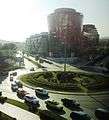 The Capital Plaza
The Capital Plaza- Telenor Center
- Delta City
- TC Kruševac
Demographics
| Year | Pop. | ±% |
|---|---|---|
| 1948 | 14,369 | — |
| 1953 | 19,868 | +38.3% |
| 1961 | 35,054 | +76.4% |
| 1971 | 61,727 | +76.1% |
| 1981 | 96,074 | +55.6% |
| 1991 | 117,875 | +22.7% |
| 2003 | 136,473 | +15.8% |
| 2011 | 150,977 | +10.6% |
| 2018 | 199,715 | +32.3% |
Although medium-sized by European standards, Podgorica is by far the largest city in Montenegro: almost one-third of Montenegrin citizens live there. According to the 2011 census, there are 185,937 people in Podgorica Capital City, which is analogous to the metropolitan area, and includes the small towns of Tuzi and Golubovci, while 150,977 people live within the city proper.
Out of the total population of Podgorica, 48.73% are male, while 51.27% are female. The average age of the population is 35.7. Serbian is the most spoken language, with 42.4% of Podgorica citizens declaring it as their first language. It is followed closely by Montenegrin, at 41.17%. Other significant languages spoken in Podgorica are Albanian (5.53%) and Romani (1.81%).
The majority of Podgorica citizens are Orthodox Christians (78.27%), while there are significant minorities of Muslims (11.23%) and Catholics (4.27%).
| Nationality (2011 census) | Number | Percentage |
|---|---|---|
| Montenegrins | 106,642 | 57.35% |
| Serbs | 43,248 | 23.26% |
| Albanians | 9,538 | 5.13% |
| Muslims | 4,122 | 2.22% |
| Bosniaks | 3,687 | 1,98% |
| Romani | 3,988 | 2.14% |
| others | 5,820 | 3.13% |
| undeclared | 8,892 | 4.78% |
Religion
Podgorica is home to three main religious groups: Orthodox Christians, Sunni Muslims and Catholic Christians.
The Orthodox Christian population mostly originates from the local Montenegrin and Serb population, which accepted Orthodox Christianity in Middle Ages after a major split during The Great Schism. They represent the major religious group. There are various Eastern Orthodox churches in the city including St. George Church which originates from the 13th century, and the Cathedral of the Resurrection of Christ which is the largest church in the city to have been recently erected.
The Muslim population mostly originates from local Bosniaks, as well as Albanians. There are several mosques in Podgorica and Tuzi.
The Catholic population mainly consists of the local Albanian minority. The main religious site for the Catholic population located in the Konik neighbourhood is the Church of the Holy Heart of Jesus constructed in 1966, in Brutalist style which makes this object unique. Other Catholic churches are located in eastern suburb Tuzi.
| Religion | Number | Percentage |
|---|---|---|
| Orthodoxy | 145,575 | 78.29% |
| Islam | 20,883 | 11.23% |
| Catholicism | 7,947 | 4.27% |
| Other Christian | 568 | 0.31% |
| Agnostic | 225 | 0.12% |
| Atheist | 3,698 | 1.99% |
| Other | 1,961 | 1.05% |
| Did not declare | 4,583 |
Administration
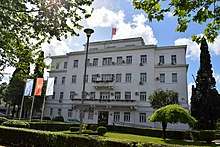
The city administration consists of a mayor, city assembly, and a number of secretariats and administrative bodies which together act as a city local government. The city assembly has 59 members, elected directly for four-year terms. The mayor used to be directly elected for a five-year term, but since the new law was introduced in Montenegrin municipalities mayors will be elected by the city assembly and will have to maintain its support during his term. Separate elections are held for the local sub-division of Golubovci since it is part of their administrative autonomy inside Podgorica municipality. Constant questions are raised by various politicians over gaining separate municipality status for Golubovci. In 2018, Tuzi became its own municipality after a vote on the Montenegrin Parliament.[35]
On local elections held on 25 May 2014, the Democratic Party of Socialists won 29 seats in the municipal assembly, one short of 30 needed to form a majority. Democratic Front won 17 seats, SNP won 8 seats, while coalition made of Positive Montenegro and SDP won 5 seats. After lengthy negotiations, SDP dissolved coalition with Pozitivna and made an arrangement on forming a majority with DPS, similar to one they have in national government. While SDP is a longtime partner of DPS at the national level, it has been in opposition to Podgorica municipal assembly in 2010–2014 period. Since October 2014, the position of the mayor is held by DPS official, Slavoljub Stijepović, replacing Podgorica mayor od 14 years, Miomir Mugoša.
City Assembly
| Party/Coalition | Seats | Local government | |
|---|---|---|---|
| Democratic Party of Socialists | 32 / 61 |
Government | |
| Democratic Montenegro | 13 / 61 |
Opposition | |
| United Reform Action | 4 / 61 |
Opposition | |
| Democratic Front | 6 / 61 |
Opposition | |
| Socialist People's Party | 2 / 61 |
Opposition | |
| Social Democrats | 3 / 61 |
Government | |
| Albanian Alternative | 1 / 61 |
Government | |
Local subdivisions
The municipality of Podgorica consists of Podgorica City Proper and one subdivision (called city municipality, градске општине, gradske opštine), which is Golubovci.
The entire municipality of Podgorica is further divided into 57 local communities (мјесне заједнице, mjesne zajednice), bodies in which the citizens participate in decisions on matters of relevance to the local community.
Education
Most of Montenegro's higher education establishments are in Podgorica. It is home to the University of Montenegro, the country's most significant such institution. The following faculties are in Podgorica:
|
|
|
The university's scientific research institutes are in the city:
- Institute of Foreign Languages
- Institute of Biotechnology
- Institute of History
The Montenegrin Academy of Sciences and Arts is in Podgorica, as is the DANU cultural organization.
The Mediterranean University was founded in 2006 as the first private university in Montenegro. In the meantime, the number of private institutions for higher education has increased, like UDG - University of Donja Gorica. The municipality of Podgorica has 34 elementary schools and 10 secondary schools, including one gymnasium. The first secondary school established in Podgorica is Gymnasium "Slobodan Škerović". The rebuilt economic high school offers new features and higher quality education. The Radosav Ljumović National Library is considered the most comprehensive in Montenegro.
Transport
Public transport
Public transport in Podgorica consists of 11 urban and 16 suburban bus lines.[36] The city-owned AD Gradski saobraćaj public transport company used to be the sole bus operator until the 1990s, when private carriers were introduced. The company went bankrupt in 2001, and buses were since operated solely by private carriers.
Public transport faces competition from very popular dispatched taxi services. De-regulation and stiff competition have made taxi services very affordable. Over 20 taxi companies are operating in Podgorica with close to 800 vehicles in service. Usually, taxi companies provide a high level of service, with relatively new and uniform car fleets and GPS-tracked vehicles.
Roads
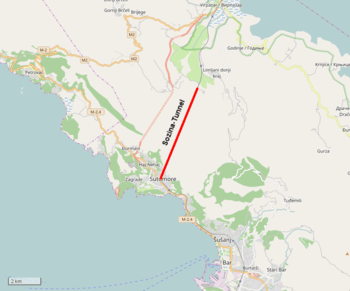
Podgorica's location in central Montenegro makes it a natural hub for rail and road transport. Roads in Montenegro (especially those connecting Podgorica to northern Montenegro and Serbia) are usually inferior to modern European roads. Both major Montenegrin motorway projects, Bar-Boljare motorway and Nudo–Božaj motorway, will pass near Podgorica. The newly built Sozina tunnel (4.2 km) shortened the journey from Podgorica to Bar (Montenegro's main seaport) to under 30 minutes. Also, a new road bypass has been constructed in 2011, to remove transport routes from north to south of the country, out of the city center. A south-western bypass has also been planned , with the same goal of moving heavy transport out of the city core. Podgorica is also characteristic of its extensive network of multi-lane boulevards which make inner-city transport quick and effective. Traffic over the Morača River also goes fluently since river banks are very well connected with 6 vehicular and 3 pedestrian bridges.
The main transit connections of Podgorica are:
Rail
.jpg)
Podgorica is a hub of the X-shaped Montenegrin rail network. The Belgrade–Bar line converges with the line to Nikšić and line to Shkodër at the Podgorica Rail Station. The station itself is located 1.5 km (0.93 mi) to the southeast of the main city square. Podgorica's main railway link (for both passenger and freight traffic) is Belgrade–Bar. The link to Nikšić was recently under reconstruction (electrification);[37] afterwards, passenger service started in October 2012. The rail link to Shkodër is used as freight-only.
Air
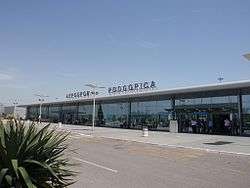
Podgorica Airport is located in Zeta Plain, 11 km (6.8 mi) south of Podgorica City centre, and is Montenegro's main international airport. The airport is locally known as Golubovci Airport (Аеродром Голубовци / Aerodrom Golubovci), as it is located within the administrative boundaries of the town of Golubovci. The IATA code of the airport is still TGD because Podgorica was named Titograd, during which time the airport opened. It is the main hub for Montenegro Airlines and Di Air.
Twin towns – sister cities
Notable people
Below are some of the most notable people who were either born or spent most of their lives in Podgorica:
- Božidar Vuković, one of the first printers among the South Slavs
- Blažo Jovanović, first President of the People's Assembly of Montenegro
- Dejan Savićević, football player, European Cup champion
- Predrag Mijatović, football player
- Stevan Jovetić, football player
- Milos Raonic, Canadian tennis player
- Duško Vujošević, Montenegrin basketball coach
- Marko Miljanov, general, clan chief and writer
- Vojo Stanić, sculptor and painter
- Risto Stijović, sculptor and painter
- Borislav Pekić, novelist
- Anđela Bulatović, handball player, Olympic silver medalist, and European champion
- Nikola Radović, football player, Olympic silver medalist
- Zoran Filipović football player and coach
- Duško Radinović, football player
- Simon Vukčević, football player
- Refik Šabanadžović football player
- Dejan Zlatičanin, boxer, lightweight WBC champion
- Dejan Radonjić, basketball player and coach
- Nikola Bulatović, basketball player
- Ljiljana Mugoša, handball player, Olympic champion
- Svetlana Mugoša-Antić, handball player, Olympic champion
- Nikola Mirotić, Spanish basketball player, Olympic bronze medalist, and European champion
- Ivan Strugar, kick-boxer
- Jovanka Radičević, handball player, Olympic silver medalist, and European champion
- Nenad Knežević "Knez", pop singer
- Sergej Ćetković, pop singer
Honorary citizens

Gallery
 Podgorica City Hall on Independence Day
Podgorica City Hall on Independence Day Monument to General Vaso Brajović
Monument to General Vaso Brajović Monument to Marko Miljanov
Monument to Marko Miljanov Monument to
Monument to
Josip Broz Tito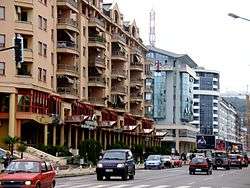 Moscow street, Preko Morače neighbourhood
Moscow street, Preko Morače neighbourhood Momišići neighbourhood
Momišići neighbourhood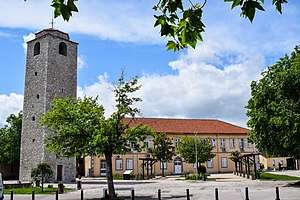 Natural History Museum and Clock Tower in the Old Town
Natural History Museum and Clock Tower in the Old Town
References
- "Montenegrin 2011 census". Monstat. 2011.
- https://www.vijesti.me/vijesti/drustvo/najvise-bjelopoljaca-i-niksicana-postali-podgoricani%3famp
- Wells, John C. Longman Pronunciation Dictionary. Pearson Longman. ISBN 978-1-4058-8118-0.
- "Podgorica" (US) and "Podgorica". Oxford Dictionaries UK Dictionary. Oxford University Press. Retrieved 11 May 2019.
- "Podgorica". The American Heritage Dictionary of the English Language (5th ed.). Boston: Houghton Mifflin Harcourt. Retrieved 11 May 2019.
- "Podgorica". Collins English Dictionary. HarperCollins. Retrieved 11 May 2019.
- Božić, Ivan (1979). "Nemirno pomorje XV veka" (in Serbian). Beograd: Srpska književna zadruga: 295. OCLC 5845972.
почетком 1474 ... о султановој намери да обнови Подгорицу и да је насели са пет хиљада турских домаћинстава, а исто тако да подигне из рушевина стари град Балеч
Cite journal requires|journal=(help) - Ćorović, Vladimir (2005). Istorija Srba (in Serbian). Zoograf. p. 357. Retrieved 21 January 2012.
...очвидно из разлога да спрече везе између Зећана и Албанаца
- Marijan-Mašo Miljić. "JUSOVAČA - KAZNENI ZAVOD U PODGORICI (1893 - 1945)" (in Serbian). Retrieved 5 January 2019.
- Perivoje Popović (7 November 2016). "Изблиза о далеком: Подгорички покољ 1874.". ИН4С (in Serbian). Retrieved 5 January 2019.
- Veliša Kadić (7 April 2013). "Podgorica: Pustoš ostaje ispod bombi". Večernje novosti (in Serbian). Retrieved 22 September 2019.
- ""Imperijal" bio najljepši". Privredna komora Crne Gore (in Serbian). 5 August 2013. Retrieved 9 June 2019.
- Morrison 2009, p. 51.
- Boban Novović. "Glavni grad je 47 godina nosio pogrešno ime: Kako je Titovgrad postao Titograd?". Vijesti (in Serbian). Archived from the original (via Wayback Machine) on 6 October 2018.
- Kovačević, Branislav. Savezničko bombardovanje Crne Gore 1943. - 1944. godine. Svjedočanstvo. Podgorica, 2003. (pg. 57)
- "Stradanje stanovništva Crne Gore u Drugom svetskom ratu". Макроекономија. 3 September 2016. Retrieved 22 September 2019.
- Slobodan Vuković. "Dolazi Tito". Vijesti (in Serbian). Archived from the original (via Wayback Machine) on 2 March 2016.
- "Pogledajte Kako Je Izgledao Ugovor O Radu '60-Ih U Fabrici "Radoje Dakić"" (in Serbian). 8 May 2018. Retrieved 16 March 2019.
- Branko Kostić. "POČECI KOMBINATA ALUMINIJUMA". Montenegrina (in Serbian). Retrieved 11 March 2019.
- Milosavljević 2003.
- Milan Milošević, Filip Švarm (29 August 1994). "Serbian President: The Technology Of A Showdown". Vreme.
- Predrag Nikolić (14 September 2018). "INICIJATIVA 100.000 STABALA ZA PODGORICU: Kome smeta drveće". Monitor (in Serbian). Retrieved 5 January 2019.
- Željko Vukmirović (17 August 2016). "Živjeti i umrijeti u Titogradu". Portal Analitika (in Serbian). Retrieved 31 January 2019.
- MONTENEGRO: NATO BOMBING ATTACKS LATEST (YouTube). Associated Press. 29 April 1999. Retrieved 16 March 2019.
- William Booth (3 May 1999). "NATO Bombs Hit Montenegro Homes". The Washington Post. p. A31. Retrieved 16 March 2019.
- "Neredi u Podgorici zbog Kosova" (in Serbian). Deutsche Welle. 14 October 2008. Retrieved 16 March 2019.
- Nemanja Rujević (15 November 2015). "Crna Gora: Protesti i ništa" (in Serbian). Deutsche Welle. Retrieved 16 March 2019.
- "Situacija u gradu se smirila" (in Serbian). Vijesti. 25 October 2015. Retrieved 16 March 2019.
- Peel, M. C. and Finlayson, B. L. and McMahon, T. A. (2007). "Updated world map of the Köppen–Geiger climate classification" (PDF). Hydrol. Earth Syst. Sci. 11: 1633–1644. doi:10.5194/hess-11-1633-2007. ISSN 1027-5606.CS1 maint: multiple names: authors list (link)
- "Climate: Podgorica". Hydrological and Meteorological Service of Montenegro. Retrieved 24 May 2018.
- "Climate of Podgorica" (in Russian). Weather and Climate (Погода и климат). Archived from the original on 29 April 2018. Retrieved 6 April 2020.
- Mugoša: Podgorica dobija svoju televiziju Archived 23 July 2011 at the Wayback Machine
- Radovinović, Radovan; Bertić, Ivan, eds. (1984). Atlas svijeta: Novi pogled na Zemlju (in Croatian) (3rd ed.). Zagreb: Sveučilišna naklada Liber.
- "Monthly Statistical Review, no. 6/2014" (pdf). Monstat. 5 May 2014. Retrieved 13 October 2014.
- "Tuzi became its own Municipality".
- "Saobraćaj". Podgorica.me. Archived from the original on 25 March 2013. Retrieved 12 March 2013.
- "U Željeznicu ulažu 52 miliona eura".
- "Gradovi pobratimi" (in Montenegrin). Podgorica. Retrieved 21 June 2020.
- "Partner cities". Yerevan. Retrieved 21 June 2020.
Sources
- Milosavljević, Olivera (2003). "Antibirokratska revolucija 1987–1989. godine". In Graovac, Igor; Fleck, Hans-Georg (eds.). Dijalog povjesničara - istoričara 8, Zadar (PDF) (in Serbian). Zagreb, Croatia: Political Science Research Centre Ltd. (PSRC) for Scientific Research Work / Zaklada Friedrich-Naumann. ISBN 953-6922-06-1. Archived from the original (PDF) on 28 September 2007. Retrieved 23 February 2013.CS1 maint: ref=harv (link)
- Morrison, Kenneth (2009). Nationalism, Identity and Statehood in Post-Yugoslav Montenegro. London: I.B. Tauris & Co Ltd. ISBN 978-1-84511-710-8.CS1 maint: ref=harv (link)
External links
| Wikimedia Commons has media related to Podgorica. |
| Wikivoyage has a travel guide for Podgorica. |

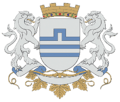
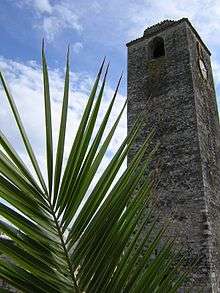

.jpg)
.jpg)
